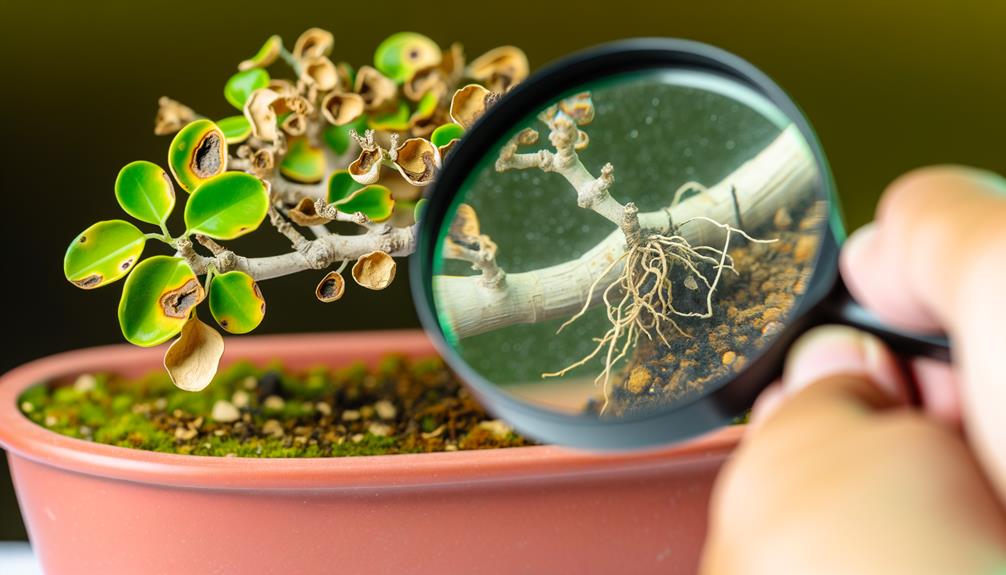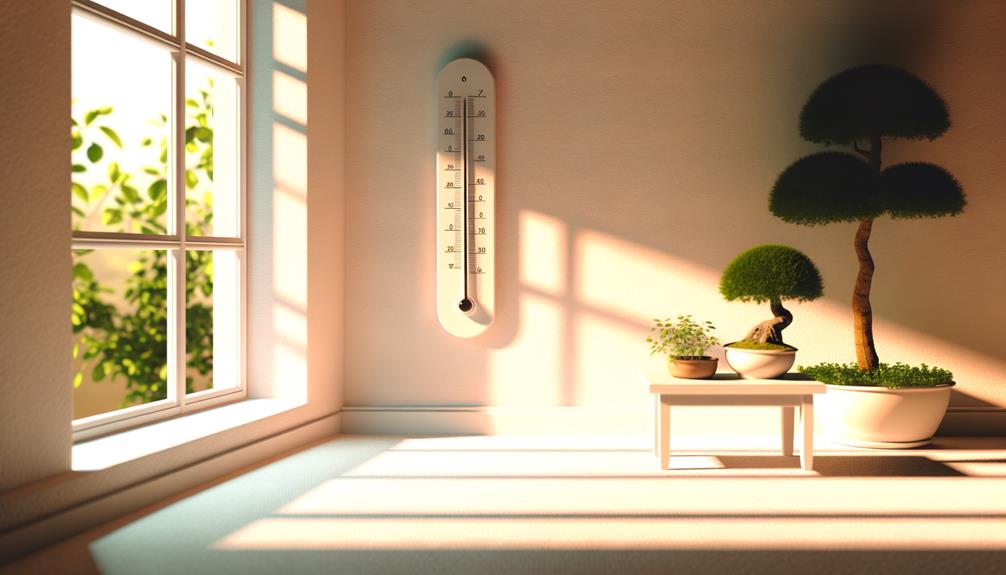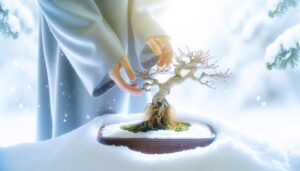You Can Revive Your Bonsai Plant: 5 Essential Steps
Reviving a bonsai plant demands thorough attention to several factors. Begin by examining for distress indicators and pests.
Evaluate sunlight exposure, humidity, and watering routines. Carefully extract the plant to inspect root integrity, eliminating any rot and confirming proper aeration.
Assess and amend soil quality, checking for sufficient moisture and nutrients. Implement precise watering techniques and use balanced fertilizers.
Prune dead branches to encourage new growth and manage pests with appropriate treatments. Regularly monitor for signs of stress or disease, maintaining consistent light and moisture levels.
This holistic approach can greatly enhance the importance of your bonsai. Discover more intricate steps to ensure long-term success.

Key Takeaways
- Assess root health by carefully extracting and inspecting for rot, and ensure proper airflow.
- Adjust watering techniques using a moisture meter and ensure proper drainage.
- Regularly inspect for pests and diseases, and treat promptly with appropriate pesticides or fungicides.
- Prune dead branches to promote new growth and rejuvenation.
- Amend soil with balanced fertilizers and monitor sunlight, moisture, and nutrient levels consistently.
Identify the Problem

To effectively revive a bonsai plant, the initial step involves accurately diagnosing the underlying issues affecting its health. Begin by observing signs of distress such as yellowing leaves, wilting, or abnormal leaf drop. Examine the foliage for pests like aphids or spider mites, which can cause significant damage.
Assess environmental factors—ensure the plant receives adequate sunlight, appropriate humidity, and correct watering frequency. Soil quality is crucial; compacted or waterlogged soil can impede root function. Utilize a pH meter to confirm soil acidity levels are within the ideal range (typically 6.0 to 7.0 for most species).
Thorough assessment of these variables enables precise identification of the problem, laying the groundwork for targeted interventions to restore the bonsai's health.
Assess Root Health
Assessing the health of a bonsai's root system is essential for diagnosing underlying issues and implementing effective restoration strategies. Begin by carefully extracting the bonsai from its container to minimize root damage.
Inspect the roots for signs of rot, which typically present as dark, mushy, and malodorous. Healthy roots should appear firm, white, or light tan. Utilize sterilized pruning shears to excise any necrotic or diseased root sections.
Additionally, examine the root ball for compactness, which may indicate poor aeration and impede water absorption. Gently tease out any densely packed roots to promote better airflow and nutrient uptake.
Check Soil Conditions

Assessing soil conditions is crucial for the revitalization of a bonsai plant. This process begins with evaluating soil moisture levels to ensure they are neither excessively saturated nor overly dry.
Following this initial step, a thorough nutrient content analysis should be conducted to identify any deficiencies or imbalances that may hinder the plant's growth. It is essential to utilize precise measuring tools and laboratory tests to gather accurate data for these assessments.
Soil Moisture Levels
Evaluating the soil moisture levels is crucial for the health of a bonsai plant, as both overwatering and underwatering can lead to severe root damage and overall plant decline.
To accurately assess soil moisture, insert a moisture meter to the root level, ensuring consistent readings. Alternatively, use the finger test by inserting your finger into the soil up to the first knuckle; the soil should feel moderately damp, not soggy or dry.
For best moisture retention, consider the substrate's composition; a mix of Akadama, pumice, and lava rock is recommended.
Regularly monitor moisture levels, especially during seasonal changes, as temperature and humidity variations can greatly impact water requirements. Adjust your watering schedule accordingly to maintain ideal moisture conditions.
Nutrient Content Analysis
Understanding the nutrient content of the soil is equally important as managing soil moisture levels, as it directly influences the bonsai plant's growth and wellbeing.
Conducting a nutrient content analysis involves evaluating macronutrients (N-P-K: nitrogen, phosphorus, potassium) and micronutrients (iron, manganese, zinc, etc.). Utilize a soil testing kit to determine nutrient deficiencies or toxicities. If imbalances are identified, amend the soil with appropriate fertilizers. Regularly monitor and adjust fertilization schedules to maintain peak nutrient levels.
Critical signs to look for:
- Yellowing leaves: Indicates nitrogen deficiency, necessitating nitrogen-rich fertilizer.
- Stunted growth: Suggests a lack of phosphorus, requiring phosphatic supplements.
- Leaf burn: Often due to excess salts or nutrient toxicity, calling for soil flushing or reduced fertilization.
Meticulous nutrient management ensures a flourishing bonsai.
Watering Techniques
Proper watering methods are crucial for the health and rejuvenation of a bonsai plant, requiring careful attention to soil moisture levels and watering frequency. Overwatering or underwatering can severely stress the plant, leading to root rot or dehydration. It is vital to understand the specific needs of your bonsai species and monitor soil moisture regularly. Utilizing a moisture meter can help in determining when to water. Watering should be thorough, allowing water to penetrate through the soil and drain from the pot's bottom.
| Condition | Action |
|---|---|
| Dry Soil | Water deeply until drainage |
| Moist Soil | Avoid watering |
| High Humidity | Reduce watering frequency |
| Low Humidity | Increase watering frequency |
| Compact Soil | Aerate soil before watering |
Adopting proper watering methods ensures ideal soil moisture, promoting plant health.
Pruning Dead Branches

Pruning dead branches is crucial for maintaining the structural integrity and overall health of a bonsai plant, necessitating precise cuts to remove necrotic tissue and promote new growth. Utilize sterilized, sharp pruning shears to make clean cuts at the base of dead branches, ensuring no jagged edges remain that could invite infection. Identify necrotic branches by their brittle texture and lack of green cambium layer beneath the bark.
- Witness the transformation from decay to rejuvenation.
- Experience the satisfaction of fostering new life in your bonsai.
- Cultivate a deeper connection with your plant through attentive care.
Regular inspection and timely pruning can greatly enhance the vitality and aesthetic appeal of your bonsai, fostering an environment conducive to robust growth.
Proper Lighting
After verifying the structural health of your bonsai through careful pruning, it is essential to provide ideal lighting conditions to support its photosynthetic needs and overall growth. Adequate lighting is essential for the synthesis of chlorophyll, which is crucial in energy production. Bonsai species vary in their light requirements, typically classified as low, medium, or high light.
| Light Level | Bonsai Species Example |
|---|---|
| Low Light | Ficus, Chinese Elm |
| Medium Light | Japanese Maple, Juniper |
| High Light | Pine, Bougainvillea |
Position your bonsai near a window that receives appropriate sunlight or use grow lights to simulate natural conditions. Maintain a consistent photoperiod, ideally 12-16 hours of light daily, to sustain optimal metabolic functions. Monitoring and adjusting light exposure is vital to prevent etiolation and other light-related stress.
Appropriate Temperature

Maintaining an appropriate temperature range is essential for the health and vigor of your bonsai, as temperature directly influences metabolic rates and physiological processes. Most bonsai species thrive in temperatures between 60-75°F (15-24°C). Drastic fluctuations can cause stress, impairing growth and increasing susceptibility to disease.
During winter, indoor bonsai should be kept away from drafty windows and heat sources. Conversely, outdoor bonsai must be protected from frost and extreme cold. Utilizing a horticultural thermometer to monitor temperature can prevent detrimental conditions.
- Consistency: Fluctuating temperatures can induce shock, leading to leaf drop and stunted growth.
- Care: Proper temperature management evokes a sense of love and dedication to your bonsai's well-being.
- Peace: A stable environment fosters peace, promoting a healthy, thriving bonsai.
Fertilizing Tips
Providing necessary nutrients through proper fertilization is crucial for the optimal growth and health of your bonsai plant. Fertilization should be customized to the specific species and growth stage of the bonsai.
Utilize a balanced fertilizer containing nitrogen (N), phosphorus (P), and potassium (K) in a ratio suitable for bonsai, commonly 10-10-10 or 14-14-14. During the growing season, typically spring and summer, apply the fertilizer every two weeks. Reduce frequency to monthly in autumn and avoid fertilization in winter dormancy.
Confirm the soil is moist before application to prevent root burn. Organic fertilizers, such as fish emulsion or bone meal, can provide a slower release of nutrients, promoting sustained growth. Always adhere to manufacturer instructions for application rates.
Pest and Disease Control

Effective pest and disease control is crucial for maintaining the health and longevity of your bonsai plant. This requires regular inspections and prompt interventions using appropriate treatments.
Begin by meticulously examining leaves, stems, and soil for any signs of infestations or fungal growth. Utilize insecticidal soap or neem oil to manage aphids, spider mites, and scale. For fungal infections, such as powdery mildew, apply a fungicide specifically designed for bonsai trees.
Vigilantly inspect your bonsai to prevent irreversible damage. Swiftly treat infestations to avoid spreading to other plants. Guarantee a balanced ecosystem to naturally deter pests and diseases.
Repotting Steps
To guarantee the best health and growth of your bonsai, it is vital to periodically undertake the meticulous process of repotting, which allows for the refreshment of soil nutrients and the management of root development. The following steps are essential for effective repotting:
- Preparation: Gather tools and appropriate soil mix.
- Root Pruning: Trim one-third of the root mass to stimulate growth.
- Repotting: Place the bonsai in a new container with fresh soil.
- Watering: Thoroughly water the bonsai to settle the soil.
| Step | Description |
|---|---|
| Preparation | Gather tools and appropriate soil mix |
| Root Pruning | Trim one-third of the root mass to stimulate growth |
| Repotting | Place the bonsai in a new container with fresh soil |
| Watering | Thoroughly water the bonsai to settle the soil |
Adhering to these steps will guarantee your bonsai thrives.
Consistent Monitoring

Regular monitoring of your bonsai is critical to identify and address any issues promptly, ensuring peak health and longevity. Frequent observation allows you to detect symptoms of stress, disease, or pest infestations early, preventing irreversible damage.
Employ detailed inspections of the foliage, soil, and roots:
- *Inspect leaf color and texture*: Chlorosis or wilting can indicate nutrient deficiencies or over-watering.
- *Check soil moisture*: Use a moisture meter to avoid root rot due to overwatering or dehydration from under-watering.
- *Examine for pests*: Look for aphids, spider mites, or scale insects that can devastate your bonsai if left unchecked.
Long-Term Care
Long-term care of a bonsai plant necessitates maintaining a balanced combination of nutrients, moisture, and light to guarantee sustained growth and resilience against environmental stressors. Regularly assess soil composition, ensuring a mix that provides sufficient drainage while retaining essential moisture.
Utilize slow-release fertilizers, rich in nitrogen, phosphorus, and potassium, to support strong development. Monitor soil moisture levels consistently, employing a hygrometer if necessary, to prevent root rot or desiccation.
Position the bonsai in an environment with ideal light exposure, typically indirect sunlight, adjusting location seasonally to accommodate photoperiod changes. Prune roots and branches periodically to maintain shape and vigor, and repot biennially to refresh soil medium.
Vigilant pest control and disease prevention are crucial, utilizing appropriate insecticides and fungicides.
Conclusion
Reviving a bonsai plant requires careful attention akin to a surgeon performing a delicate operation. Identifying the issue, evaluating root health, and checking soil conditions lay the groundwork.
Proper watering techniques act as a lifeline, while pruning dead branches breathes new life into the plant. Watchful pest and disease control, along with strategic repotting, fortifies its foundation.
Regular monitoring maintains ongoing health, while long-term care secures its future, transforming a fading bonsai into a flourishing masterpiece.






